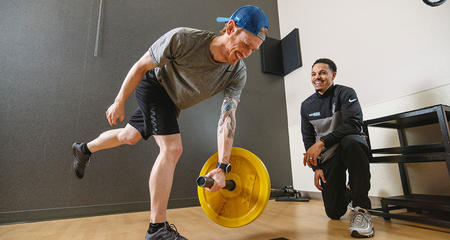As one of the leading Sports Medicine Centers in the Midwest, we use state-of-the-art diagnostic tools and physician-driven, evidence-based treatments to help keep athletes of all levels at their best.
Motion Analysis System
Our digital motion analysis system uses multiple cameras and sensors to accurately measure how an athlete moves – from a golf swing, to a baseball pitch, soccer kick or a dance move – to help improve performance and reduce the risk of injury.
DEXA Scanning (Bone Density Scanning)
All women, but particularly female athletes, are at risk for developing osteoporosis or bone loss. DEXA, which stands for "dual energy X-ray absorptiometry," is the most commonly used test for measuring bone mineral density, as wells as one of the most accurate ways to diagnosis osteopenia or osteoporosis.
DEXA scans are more accurate than standard X-rays, as a person would need to lose 20-30 percent of their bone density before it would show up on an X-ray. DEXA requires less radiation exposure than CAT scans or radiographic absorptiometry. In fact, you are exposed to more radiation on a coast-to-coast airline flight than you are during a DEXA scan.
Electrodiagnostic Evaluation
An electrodiagnostic evaluation can help diagnose pain, numbness or weakness involving the peripheral nervous system and muscles. Consisting of non- or minimally-invasive procedures, the evaluation delivers small electrical impulses to affected body regions. Test results provide information about the ability of muscles to respond to stimulation and the rate at which an electrical impulse moves through nerves, aiding the development of treatment options.
The first part of the evaluation is called the nerve conduction study, which examines how information is sent that allows you do things such as walk or reach and hold objects. The speed and number of nerve fibers are evaluated. The second part of the evaluation is called the electromyography or ‘EMG.’ An EMG analyzes the health of the muscles and the nerves that control the muscles both at rest and during muscle contraction.
X-Ray Radiology
The Froedtert &MCW Sports Medicine Center utilizes on-site digital X-ray technology. Advanced technology allows X-ray images to be viewed and stored digitally with the use of specialized computer software.
Our board-certified physicians are highly specialized in interpreting the X-ray images. The digital format allows for quick interpretation, results, and explanation from a computer viewing station located right in the physician’s exam room.
VO2 Max/Anaerobic (Lactate) Threshold Testing
 VO2 max and anaerobic threshold are predictors of your endurance. Both are very important if you are training for an endurance event or want to know your training parameters.
VO2 max and anaerobic threshold are predictors of your endurance. Both are very important if you are training for an endurance event or want to know your training parameters.
V02 Max (Maximal Aerobic Power Testing)
V02 max is the maximum amount of oxygen that can be used by muscles in a given period of time. VO2 max is your maximal rate of oxygen consumption and a measure of your capacity to generate the energy required for endurance activities.
To assess VO2 max, the athlete performs progressively intensive exercise, during which ventilation and oxygen concentration of inhaled and exhaled air are measured. VO2 max testing is performed on a bike or treadmill and a metabolic analysis is done.
The results provide max levels of heart rate, VO2, VCO2 and anaerobic threshold.
Anaerobic Threshold
Anaerobic threshold testing, also called lactate threshold testing, measures the point at which lactate removal fails to keep up with the rate of lactate production as exercise intensity increases. At the anaerobic threshold, lactate starts to accumulate in the blood because it is produced faster than it can be removed (metabolized).
The anaerobic threshold is a useful measure for determining exercise intensity for training and racing in endurance sports. Athletes can increase their lactate threshold through proper training.
More to Explore





